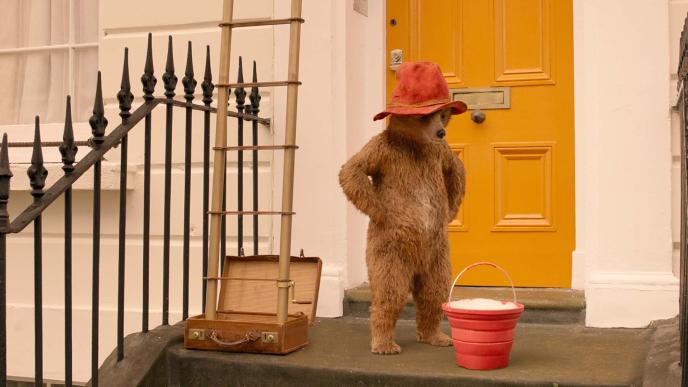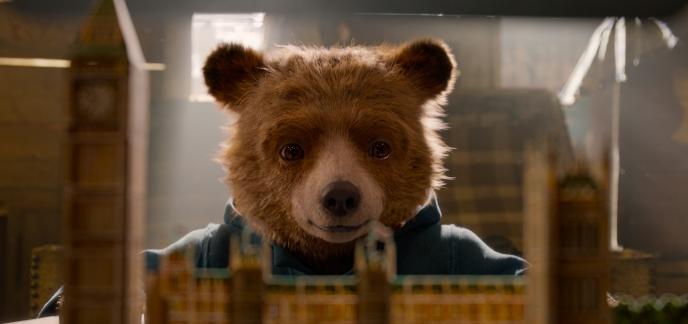‘Paddington 2’: How To Find A Character’s Performance
Paul King’s first Paddington movie, released in 2014, has a whopping 98% score on the review aggregation site Rotten Tomatoes. Amazingly, the score is bettered by the film’s sequel, Paddington 2 – at 100% at the time of writing – with the follow-up widely loved for its charming approach to the famous British storybook character.
In both films, Paddington is an entirely cg creation voiced by actor Ben Whishaw and brought to life by Framestore. The visual effects studio spent countless hours perfecting a performance from the bear for the first film, and refining it even further for the sequel.
Cartoon Brew sat down with Framestore animation supervisor Pablo Grillo in London to find out just what was involved in ‘finding’ the animation style for Paddington, and filtering that amongst the nearly 80 animators on the show.
Paddington is a bipedal bear who walks upright along with the live-action actors. That aspect of his character, of course, informed how Framestore designed the anatomy. “We had to make his pelvis a cross between something quadrupedal and something bipedal,” said Grillo. “It’s impersonating a quadruped, but the legs stick out the bottom. For the length of the legs, we wanted to make them feel short through the groom, but give them enough length underneath that they keep up in a walk.”
For the first film, Framestore carried out animation tests early on with a rough version of their initial model, but, says Grillo, continued to ‘find’ the character as production continued. Animators would take key moments from the script, for example, and run through the tests to check that the geometry of their model worked.
“There was a scene where Paddington was eating spaghetti,” recalled Grillo. “It didn’t make it into the film, but we’d play with that and just sort of try and get a feeling for whether his arms worked, and at the same time get a sense of the humor and how he could feel as a comic actor.”
Other tests were carried out for walk cycles or for Paddington going up and down stairs. There was a key ‘aha’ moment where the animators filmed an early live-action test – it was one that got many on the production excited about Paddington as a character, says Grillo.
“We got a camera out in Wells Mews, which is here in London, around the back of Framestore. And I walked down the street, and we animated a little scene of Paddington holding my hand, just to see how he felt in the live-action space. And that was the thing that got everyone’s juices going. It was the first insight into who he was or how it could feel as a film.”
That test, and the final animation for Paddington, in general, followed a minimalist style. That does not mean that the character does not get involved in a number of action scenes, or even slapstick scenes, but Grillo says Paddington’s design and behaviors lent themselves to a more gentle approach.

“He’s very symmetrical by design,” said Grillo. “He doesn’t kind of lean his facial expressions to one side or the other. He doesn’t go for the asymmetries and things that I guess normally you’d say, ‘Oh, you do those things to add interest.’ He’s also very much plunked in the space and will often just stand there and look around.”
“And I think there’s also a degree of inscrutability, because he’s such a thoughtful character,” added Grillo. “He’s a thinking character. So everything is revealed through very specific actions – the results of those thought beats. It’s very underplayed; it doesn’t show his emotions. I think he reveals them through the course of action that he takes off the back of having thought about it first. There’s a real economy there.”
In terms of facial animation, one of the biggest challenges for Framestore was finding a line between a photorealistic hairy bear and one that still had to play like a storybook character. “It’s so easy to wade into the grotesque or the ugly and lose the charm,” noted Grillo. “So it was trying to maintain simplicity in the forms, but at the same time complexity, that gives you realism.”
Framestore manages a database of previous animated performances and film reference for the animators to look to. For Paddington, some Charlie Chaplin footage was often referred to for the right tone of the character. Other reference even included close-up videos of eye blinks and eyeball movements for the final character detail.
“When it comes to that final layer,” said Grillo, “we say to the animators, ‘Okay, watch these videos and make sure you do your blinks like this. Look at each eye dart and what the lids do here, because this is the key to making good looking darts.’ And that’s just an old video of my eyeball that I shot for a film way back, but it’s still a great thing to point at and go, ‘You know what, that’s how an eye flickers.’”

Whishaw’s voice performance is certainly something Framestore used as reference, too, but not necessarily in any kind of performance capture way (interestingly, the first film initially featured Colin Firth as the voice of Paddington, before Whishaw came on board).
“On this film Paul [King, director] did many, many passes of recording with Ben to find the right intonation for a scene,” said Grillo. “And on top of that, there’s all the grunts and sounds that he meticulously edits into place, which all help with sculpting Paddington’s character. That’s something we didn’t have in the first film. Ben came very much at the end of the process, and we were still finding the bear and working out who he was.”
During filming for Paddington 2, several methods were employed to shoot empty plates that would later require the incorporation of a cg character. Eye-line markers were some of the most common techniques used to help the actors and camera operators, with some even set up with moving light diodes if the character was to be walking in a scene. Actress Lauren Barrand also stood in for Paddington in other instances. Finally, the production relied on stuffies and a furry Paddington head for lighting reference.
Once things got into post-production, the next challenge for Framestore was ensuring that all the animators – mostly in Montreal and London – were on board with how to craft Paddington as a character – it was the culmination of lessons learned on the first film and a continued exploration of who Paddington should be.
“It takes people time to get into the flow,” said Grillo. “At the beginning, it’s incredibly slow. Your first scenes that are turned over take a lot of iterating, they take a lot of time to finish. By the time you’re at the end, you’re running a huge bandwidth of shots going through at the same time. But at that point, you’ve hit your pace and people are in the zone and they know how Paddington works.”
See the full article on Cartoon Brew.